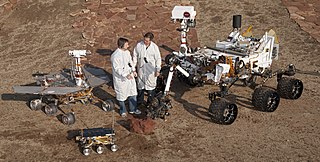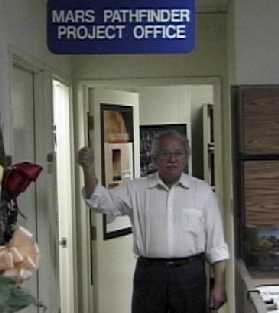
Pocari Sweat is a Japanese sports drink, manufactured by Otsuka Pharmaceutical. It was launched in 1980, and is mostly well known across Asia and the Middle East; it is also available in East Asia, Southeast Asia, Australia and Mexico.

A moonbase is a facility on or below the surface of the Moon, enabling human activity on the Moon. As such, it is different from a lunar space station in orbit around the Moon, like the planned Lunar Gateway of the Artemis program. Moonbases can be for robotic or human use, in both cases not necessarily including lunar habitation facilities.

A rover is a planetary surface exploration device designed to move over the rough surface of a planet or other planetary mass celestial bodies. Some rovers have been designed as land vehicles to transport members of a human spaceflight crew; others have been partially or fully autonomous robots. Rovers are typically created to land on another planet via a lander-style spacecraft, tasked to collect information about the terrain, and to take crust samples such as dust, soil, rocks, and even liquids. They are essential tools in space exploration.

Anthony Spear is an American space exploration project manager most notable for leading the Mars Pathfinder mission for JPL/NASA in 1996. He retired from JPL in 1998. He competed for the Google Lunar X Prize with Red Whittaker, Astrobotic, and Carnegie Mellon University, where he received a B.S. degree in electrical engineering in 1962.

Astrobotic Technology is an American private company that is developing space robotics technology for lunar and planetary missions. It was founded in 2007 by Carnegie Mellon professor Red Whittaker and his associates with the goal of winning the Google Lunar X Prize. The company is based in Pittsburgh, Pennsylvania. Their first launch occurred on January 8, 2024, carrying the company's Peregrine lunar lander on board the first flight of the Vulcan Centaur Rocket from Florida's Space Force Station LC-41. On June 11, 2020, Astrobotic received a second contract for the Commercial Lunar Payload Services program. NASA will pay Astrobotic US$199.5 million to take the VIPER rover to the Moon, targeting a landing in November 2024.

Hakuto (ハクト) or formerly White Label Space (ホワイトレーベルスペース) was a team formed in early 2008 by a group of experienced space professionals inspired by the challenge of the Google Lunar X PRIZE to develop a robotic Moon exploration mission.

A lunar rover or Moon rover is a space exploration vehicle designed to move across the surface of the Moon. The Apollo Program's Lunar Roving Vehicle was driven on the Moon by members of three American crews, Apollo 15, 16, and 17. Other rovers have been partially or fully autonomous robots, such as the Soviet Union's Lunokhods, Chinese Yutus, and the Indian Pragyan. Four countries have had operating rovers on the Moon: the Soviet Union, the United States, China and India.

The Lunar CATALYST initiative is an attempt by NASA to encourage the development of robotic lunar landers that can be integrated with United States commercial launch capabilities to deliver payloads to the lunar surface.
Arch Mission Foundation is a non-profit organization whose goal is to create multiple redundant repositories of human knowledge around the Solar System, including on Earth. The organization was founded by Nova Spivack and Nick Slavin in 2015 and incorporated in 2016.

Commercial Lunar Payload Services (CLPS) is a NASA program to contract transportation services able to send small robotic landers and rovers to the Moon's south polar region mostly with the goals of scouting for lunar resources, testing in situ resource utilization (ISRU) concepts, and performing lunar science to support the Artemis lunar program. CLPS is intended to buy end-to-end payload services between Earth and the lunar surface using fixed priced contracts. The program was extended to add support for large payloads starting after 2025.
CubeRover is a class of planetary rover with a standardized modular format meant to accelerate the pace of space exploration. The idea is equivalent to that of the successful CubeSat format, with standardized off-the-shelf components and architecture to assemble small units that will be all compatible, modular, and inexpensive.

Beresheet was a demonstrator of a small robotic lunar lander and lunar probe operated by SpaceIL and Israel Aerospace Industries. Its aims included inspiring youth and promoting careers in science, technology, engineering, and mathematics (STEM), and landing its magnetometer, time capsule, and laser retroreflector on the Moon. The lander's gyroscopes failed on 11 April 2019 causing the main engine to shut off, which resulted in the lander crashing on the Moon. Its final resting position is 32.5956°N, 19.3496°E.

Peregrine Mission One, or the Peregrine Lunar Lander flight 01, is a lunar lander built by Astrobotic Technology, selected as a part of NASA's Commercial Lunar Payload Services (CLPS). It was launched 8 January 2024, at 2:18 am EST by United Launch Alliance (ULA) aboard the maiden flight of the Vulcan Centaur. The lander carries multiple payloads, with a total payload mass capacity of 90 kg. It would have been the first US-built lunar lander to launch since the crewed Lunar Module from the Apollo program, but a fault occurred shortly after separation from the rocket and the attempt to land on the moon had to be abandoned.

VIPER is a lunar rover developed by NASA, and currently planned to be delivered to the surface of the Moon in November 2024. The rover will be tasked with prospecting for lunar resources in permanently shadowed areas in the lunar south pole region, especially by mapping the distribution and concentration of water ice. The mission builds on a previous NASA rover concept called Resource Prospector, which was cancelled in 2018.

John Patrick Thornton is an American business executive. He is CEO of Astrobotic Technology Inc. which develops technology for lunar and planetary exploration.

DHL MoonBox is a mementos box that was launched to the Moon in 2024 on Astrobotic Technology's Peregrine Lunar Lander. The DHL MoonBox is made by DHL. It contains 28 capsules all of which have been filled. It contains items from the USA, UK, Canada, Nepal, Germany and Belgium.
Memory of Mankind on the Moon is a time capsule that was launched onboard Astrobotic Technology's Peregrine lander. It is made in collaboration with Hungarian company Puli Space Technologies and Memory of Mankind.

Yaoki is a Moon rover made by Japanese company Dymon to be launched in 2023 by American company Astrobotic Technology on their Peregrine lunar lander. Yaoki was first announced in 2019.
















